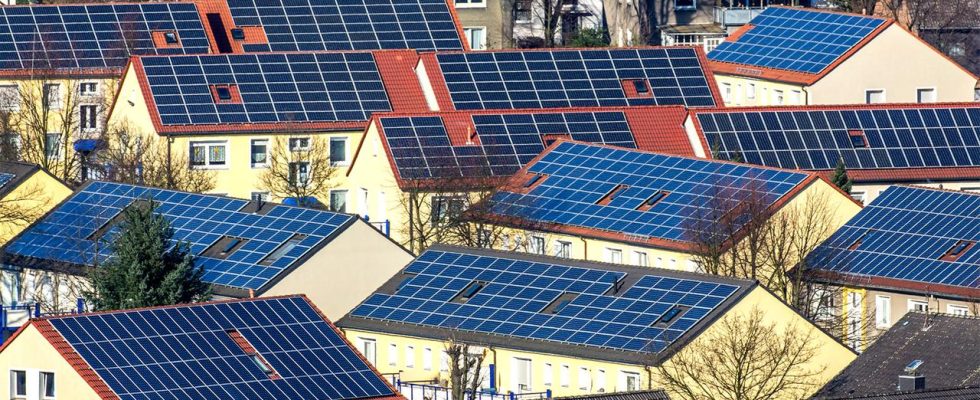Even today, sometimes electricity from the solar roof cannot be fed into the grid because it is overloaded. With the expansion of renewables, the entire energy infrastructure must grow.
More and more internet-enabled devices, smart homes, electromobility, heat pumps – electricity consumption at home continues to rise. Many homeowners come up with the idea of producing their own electricity, for example using a balcony power plant – or, if they want something bigger, using photovoltaics on the roof. And the excess electricity should be fed into the grid in order to recoup some of the costs more quickly. But that doesn’t work everywhere.
Some networks are already at their limit
Burkhard Spang is planning a photovoltaic system with connected storage and a wallbox for an electric car for the roof of his house in Blieskastel, Saarland. Master electrician Udo Schmidt advised him and will install the system. But both have a problem: Spang is not allowed to feed the excess electricity that he does not need into the Blieskastel power grid – say the responsible Bliestal municipal utilities. For technical reasons, as they say. Apparently the network is not up to date.
This is not an isolated case: nationwide, the power grids in their current state are not designed for the goals of the traffic light coalition. The network operator E.ON also points this out when asked. The energy, heat and mobility transition requires not only a massive expansion of renewables, “but also the synchronous expansion of the energy infrastructure – for example new lines, transformers and substations.”
billions Investments
E.ON. itself plans to invest 26 billion euros in the network infrastructure by 2027, most of it in Germany. Investments in the three-digit billion range will be necessary by 2045.
According to its own information, the EnBW Group is currently investing around two billion per year in network expansion, half of which is in the regional distribution network. That is more than twice as much as in the past.
The subsidiary Netze BW alone, the largest distribution network operator in Baden-Württemberg, has to expand almost all of its more than 300 substations and build a double-digit number of new substations.
“A feat of strength”
There is also an immense need for expansion and expansion in the management area. “For this feat to succeed, we urgently need faster approval procedures as well as broad acceptance and support from politicians and society for the specific projects on site,” says EnBW board member Dirk Güsewell.
“Before the energy transition, the main thing was a cost-efficient power grid,” says the Association of Electrical, Electronic and Information Technology (VDE). “We currently have to make the transition to a system with millions of decentralized renewable energy systems and high-performance customer systems.”
500,000 new heat pumps per year, millions of electric cars – these are the official goals. According to VDE information, a household with a heat pump and wallbox requires around 15 kW of power – without these two devices it is around four kW.
Over 12,000 kilometers of new power lines
In addition, there is the expansion of solar energy – by nine gigawatts (GW) in 2023, by 13 GW in 2024 and by 18 GW in 2025, according to the goals. “Due to the spatially unequal distribution, the volatility of renewables and the new consumers, the flows in the network are changing dramatically,” says the VDE.
The network needs to be expanded in places. The VDE expects more than 12,000 kilometers of new lines onshore and offshore by 2045. But the local distribution networks would also have to be expanded.
Intelligent control against overload
In order to make optimal use of the existing power grid, intelligent controls, so-called “smart meters,” should help. They act as interfaces between electricity consumers, the market and the grid. For example, charging processes for cars can be started or postponed in a targeted manner if, for example, there is little electricity from renewable energies available. Storage systems are intended to compensate for fluctuations and provide control energy.
A current project by Stadtwerke Saarbrücken and the electrical installation manufacturer Hager shows what this could look like in the future. Intelligent, digital control should prevent overloads, if possible without having to expand existing networks. In an initial test phase, the measuring devices will be tested under laboratory conditions, after which the project will continue with selected households in which heat pumps and electric cars are already being used.
Photovoltaics is increasing rapidly
The VDE currently recommends that homeowners with a photovoltaic system consume or store the electricity produced themselves if possible. Network operators could not prevent a so-called “grid connection request”, but could temporarily reject it if the network capacity was not sufficient.
Figures from Baden-Württemberg show that demand is increasing. The EnBW subsidiary Netze BW currently receives up to 7,000 applications per month for the connection of photovoltaic systems – whether balcony power plants, roof systems or open-space systems. Last year there were 4,000 per month, and in previous years it was 1,000 to 1,500. Next year the company expects 9,000 applications per month.

